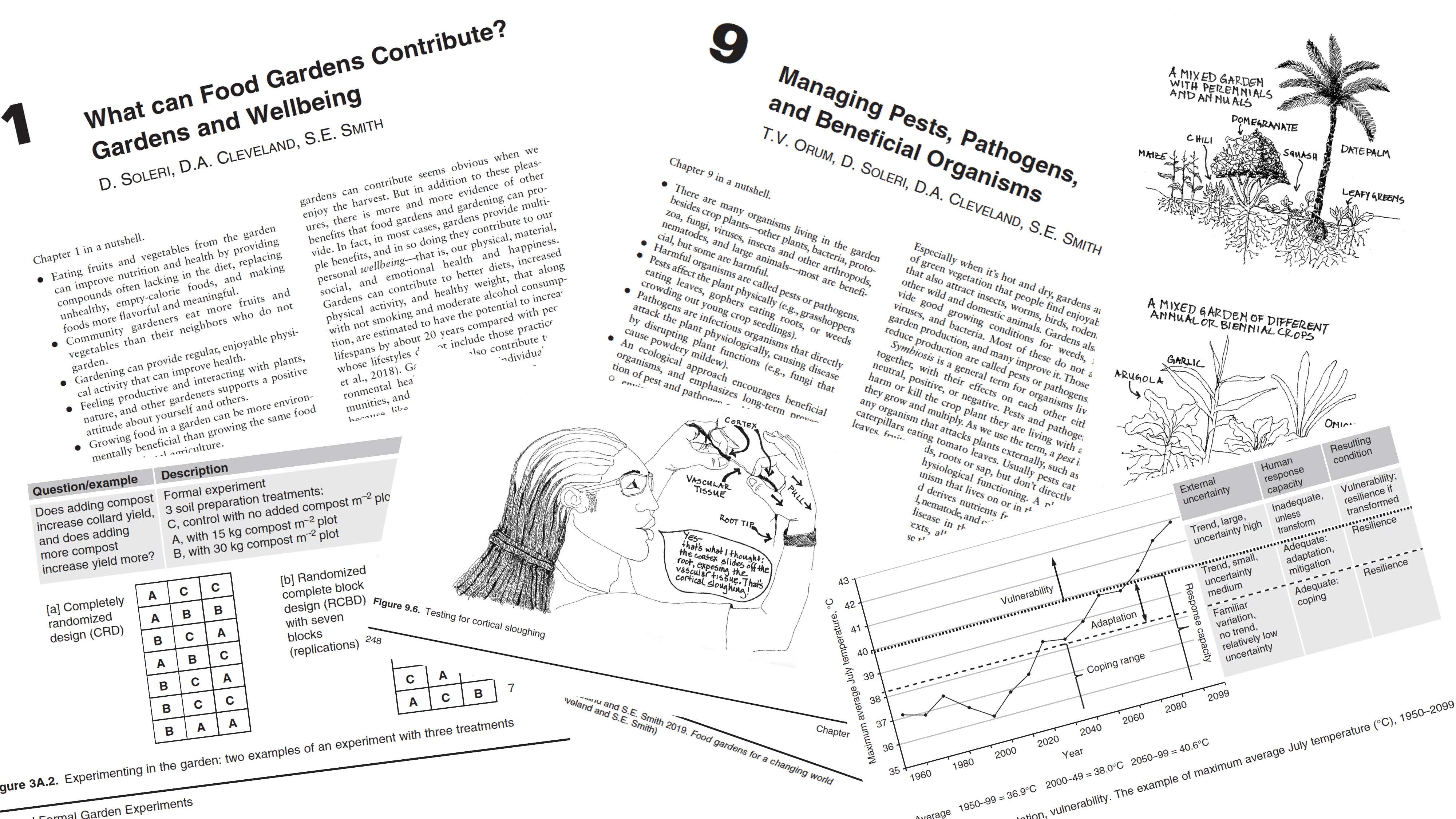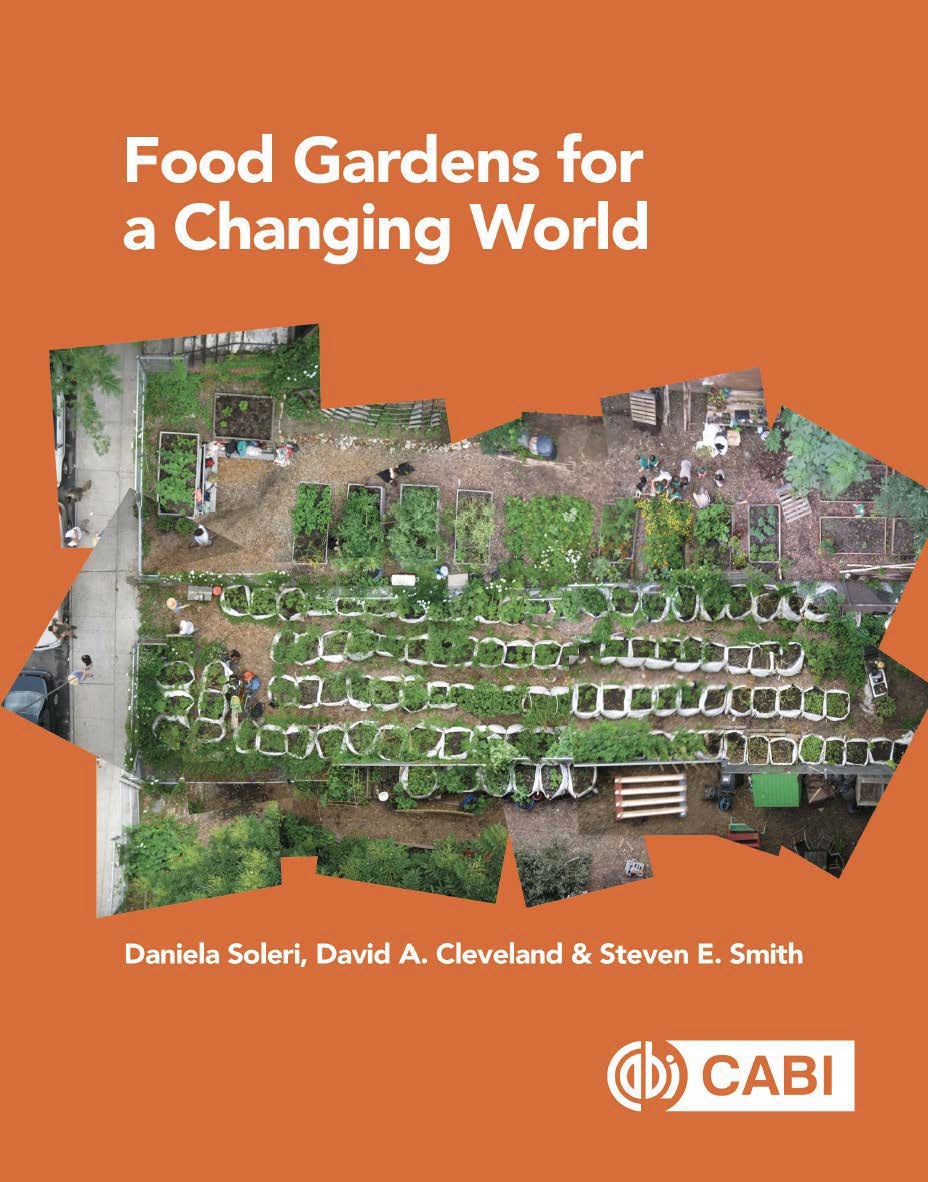| |
|
Synopsis
Food Gardens for a Changing World is a unique resource for students, researchers, and policymakers, as well as household, community and school gardeners, who want to understand the potential of food gardens in a rapidly changing world. This book focuses on the new challenges to food gardening brought by major 21st century trends: the global climate crisis, environmental degradation, resource scarcity, and social inequity. Examples throughout the text demonstrate how to use basic biological, ecological and social concepts to respond successfully to those challenges.
Key features
- Explanations of the new challenges that major 21st century trends are bringing to food gardens and gardeners.
- Worked examples demonstrate how garden observation and experimentation can help determine the best options for responding to change.
- Chapters cover management of garden location, plants, pests & pathogens, water, soil, and seeds, as part of human and environmental communities.
- An open, accessible style, over 100 graphs and illustrations, and evidence-based, well-referenced explanations and examples help readers understand basic concepts and find further information.
- Examples show how the basic concepts can be adapted for different circumstances, focusing on hotter, drier areas, especially the western US, but relevant worldwide.
- Application of these concepts is guided by aframework of five key ideas based on research in the natural and social sciences. That framework supports the goals of minimizing harm to the environment, mitigating and adapting to climate, environmental and social change, and strengthening prosocial strategies that support gardener-scientist collaboration, and food justice.
Five key ideas
- Ecological thinking Garden resources like soil, organic matter, water, seeds, and beneficial organisms have lifecycles that extend beyond our gardens. Thinking of entire lifecycles makes it easier to manage them in response to climate, environmental and social change, in ways that optimize benefits for everyone. For example, How can we replace soil amendments, such as peat for nursery beds and containers, with other amendments to reduce the high greenhouse gas emissions resulting from mining peat, exposing soil layers beneath it, and transporting the peat to our gardens?
- Evolution by selection All living organisms are the result of evolution by selection. How we garden continues this process by favoring locally adapted crop plants and other living organisms in the garden over others. For example, How can we select plants of our favorite garden crops so that they continue to be productive as the climate changes, and temperatures rise?
- Prosocial behavior Among humans’ wide range of potential behaviors, prosocial ones are necessary for successful communities and gardens. Prosocial behaviors in managing resources can conserve those resources and support access to garden benefits in ways that advance social justice. For example, How can we use increasingly scarce water in our garden so that today’s gardeners all have a fair share, and future generations also have water for their gardens?
- Social organization The way we organize ourselves for food gardening affects our ability to reach the prosocial goals we have for our behavior, our communities, and our environment, including the climate. The best scale and form of organization will depend on our specific goals and the methods we are using. For example, Is the best way to minimize greenhouse gas emissions from garden and food waste to compost at the garden, or to support centralized community composting?
- Knowledge diversity Local gardeners often understand many aspects of their physical and social environments far better than scientists. Scientific knowledge can complement gardeners’ knowledge and also contribute methods for research that support gardeners’ own goals. For example, What characteristics do gardeners think are important for identifying locally-adapted crop varieties, and what is the best way to select for these?
Authors
Daniela Soleri (University of California, Santa Barbara, and The Center for People, Food & Environment) is an ethnoecologist whose research focus is local and scientific knowledge systems in small scale agriculture and gardens. This includes quantifying farmer practices, documenting risk assessment and cultural identity related to seeds, and investigating new semi-formal seed networks, and community science as a problem-solving strategy.

David A. Cleveland (University of California, Santa Barbara, and The Center for People, Food & Environment) is a human ecologist who has done research and development project work on sustainable agrifood systems with small-scale farmers and gardeners around the world. His current focus is the role of local food systems and diets in climate change, nutrition, and food sovereignty.
Steven E. Smith (University of Arizona) is a plant breeder, botanist and statistician  whose research, training of students, and teaching cover those areas of expertise. His research interests reflect both his training in application-oriented plant breeding and his fascination with plant survival in natural plant communities in arid environments. whose research, training of students, and teaching cover those areas of expertise. His research interests reflect both his training in application-oriented plant breeding and his fascination with plant survival in natural plant communities in arid environments.
Table of Contents
Introduction
PART I. STARTING AT THE BEGINNING: GARDENS AND THE BIG PICTURE
Chapter 1. What can food gardens contribute? Gardens and wellbeing
Appendix 1A Nutrients and energy in garden foods
Chapter 2. Changes coming to your garden
Chapter 3. Responding to change as a food gardening strategy
Appendix 3A Worked formal garden experiments
PART II. STARTING THE GARDEN
Chapter 4. Garden placement
Chapter 5. How plants live and grow
Chapter 6. Starting and caring for garden plants
PART III. GARDEN MANAGEMENT
Chapter 7. Soil, nutrients, and organic matter
Chapter 8. Water, soils, and plants
Chapter 9. Managing pests, pathogens, and beneficial organisms
Chapter 10. Saving seeds for planting and sharing
Index

Endorsements
Observe, test, learn, adapt: a culture of respect for empiricism may be what we most need to grow in our gardens and food systems—the front lines of humanity’s survival in a changing climate. This book is a resource for communities to take charge of their gardening through experimentation, and for scientists to adjust their practices towards transparency and mutual respect. The readable concepts and examples provided show how to equitably partner across formal science and informal garden institutions, and collaborate to produce and use diverse knowledge—essential for improving our individual and collective capacity to change.
Liz Barry, Director of Community Development, Public Lab, USA (Public Laboratory for Open Technology and Science)
The unique contribution of Food Gardens for a Changing World is to combine findings from the natural and the social sciences to allow us to understand better the new challenges food gardening faces. For growing food is not just a matter of maintaining healthy soils and cultivating the plant: it is also about strengthening links with others, co-finding solutions with scientists, and ultimately, by reconnecting with nature, healing communities.
Olivier De Schutter, LL.M., Ph.D., former United Nations Special Rapporteur on the Right to Food (2008-2014), co-chair of the International Panel of Experts on Sustainable Food Systems, Belgium (IPES-Food); Professor, Catholic U of Louvain and Sciences Po, Paris
After perusing Food Gardens for a Changing World , I decided to use it as one of the required readings for my non-majors “California Cornucopia” course. The typical student is a last-quarter Senior who has put off their science class until the end of their career. This is a last chance to de-toxify science for non-scientists about to enter their career path. Therefore, the course is broad,but necessarily spotty—using California crops and their products to teach the basics of cell biology, ecosystem science, evolution, genetics, and the interaction of science and all aspects of sustainability. Using this book will give me the opportunity to make sure that every aspect of the science of growing plants—including their connection to health and sustainability—is covered in a straightforward way. I especially like how the science is interwoven with practicality. The price of the paperback brings it within the budget of most undergraduates. Students will find the accessible prose and lively artwork a surprising comfort for a science book.
Norman C. Ellstrand, Ph.D., Distinguished Professor of Genetics, Jane S. Johnson Endowed Chair in Food and Agriculture, Founder & Director, CAFE (California Agriculture + Food Enterprise), University of California, Riverside, USA
Food Gardens for a Changing World is a rich and comprehensive resource written by thoughtful, creative scientists in service to gardeners and small-scale farmers. It weaves prosocial culture, scientific documentation, best garden practices, botanical basics for seed savers, and a big picture look at challenges for food production that have already arrived with increasing global temperatures of climate change. Reference lists encompassing the breadth of ideas presented are extensive for every chapter. I love how this book builds on its five key ideas and layers foundational “beginner mind” concepts, highly complex systems thinking, scientific studies and models, genetic considerations for gardeners, how gardening affects diet, exercise and mental state, and the art of amateurobservation with citizen science. This tapestry includes vibrant color and texture threads of community interactions and cooperation, friendly conversations about growing our own food while sharing earth’s precious resources, and sharing favorite recipes. As a seed saver and seed activist, I found Part III on Garden Management to be especially engaging, capturing my full attention on details that brought new perspectives for consideration. The authors have successfully collaged their individual backgrounds and fields of interest. I highly recommend Food Gardens for a Changing World to all gardeners everywhere to encourage deeper understanding of prosocial actions and thinking that promote knowledgeable, equitable, culturally relevant, and delicious dinners for their communities and for future generations.
Elizabeth Johnson, artist and seed steward, San Luis Obispo Seed Exchange, USA
What can one do to live more pleasurably and sustainably in this period of rapidly changing social and ecological circumstances? This stimulating and inspiring—yet practical—book suggests that you put some seeds in the ground and learn to nourish your plants, your place, your body, and your mind. Beginners will find the book an effective guide to taking the first steps into establishing and maintaining a rewarding garden. Experienced gardeners will discover a wealth of information about the scientific underpinnings of their practice and how they can adjust to a changing environment.
Jack R. Kloppenburg, Jr., Ph.D., Professor Emeritus, University of Wisconsin-Madison, USA, Secretary, Open Source Seed Initiative
Food Gardens for a Changing World is a gardening book for gardeners who seek to interrogate their efforts in the larger global context while still attending to the intimate considerations of what makes the garden grow. It is a book for home and community gardeners who have moved beyond the seductive images of strawberries and kale that embellish the typical garden book and instead seek to study their gardens, reflect on their significance amid global and local change, and improve their garden’s productivity while enriching their personal experience. Food Gardens for a Changing World is encyclopedic in its breadth of information and provides rich references and bibliographic information to encourage further research. Community gardeners and their supporting institutions will find this book a must-have for guidance in environmentally friendly, socially equitable production and documentation of community gardens' benefits. This book will undoubtedly be the ‘go to’ book on any inquisitive gardener’s bookshelf.
Laura J. Lawson, Ph.D., Dean of Academic Programs, Professor of Landscape Architecture School of Environmental and Biological Sciences, Rutgers University, USA
Food Gardens for a Changing World will be of broad interest to academics, students, and gardeners who want to know more about how gardens function both ecologically and socially. It will be especially useful here in Australia, where the effects of climate change are increasingly being felt. The authors provide support for gardeners to go out and run their own experiments to better understand the processes happening above and belowground in their garden plots. Readers will enjoy the beautiful drawings that help elucidate all the wonderful ways people use and explore their gardens.
Brenda Lin, Ph.D., Research Scientist, CSIRO, Australia
This engaging book is a must-have resource for anyone involved or interested in small-scale food production, from gardeners to instructors to entrepreneurs to community empowerment programs. Based on the latest research in multiple academic fields, the authors provide up-to-date and thoughtful guidance on how to think about, create, maintain and benefit from gardens in different environments and changing climates. Look here for answers to all your questions: How can gardens combat greenhouse gas emissions? How do plants take up soil nutrients? Should I consume organic or non-organic fruit? What vital social and cultural resources are provided by community gardens? How does eating a cookie compare nutritionally with an apricot? How do gardens improve mental and physical health? Why and how do bees and other insects pollinate crops? How much of my family’s budget can I save if I grow my own? Food Gardens for a Changing World provides comprehensive, detailed yet contextual information across the biophysical, ecological, agronomic, social, economic, and political aspects of locally-grown produce.
Deborah K. Letourneau, Ph.D., Professor Emerita, Department of Environmental Studies, University of California, Santa Cruz, USA
Food Gardens for a Changing World compiles a large volume of information about how gardens can serve as a system for understanding people’s connection with productive landscapes and how these settings are so much more than just a piece of land to grow food. Through scores of examples, the authors stitch together a compelling case for how and why these parcels of land serve as a microcosm for healthy, active, and sustainable lifestyles and social and emotional wellbeing, and that these nodes are part of broader food networks and thus have the potential to ignite system level changes. Importantly, Food Gardens for a Changing World nicely balances the presentation of scientific evidence supporting gardens as a social, health, and ecological resource, with practical information about the art and science of gardening under rapidly changing environmental and social conditions.
Jill S. Litt, Ph.D., Associate Professor, University of Colorado, Boulder, USA , Associated, Researcher, ISGlobal, Spain (Barcelona Institute for Global Health)
There is so much I like about this book. It's organized like a text book and reference book, but reads like a conversation with a wise and trusted friend. It is full of useful, practical tips and resources—especially for people who are interested in adapting their gardening to changing conditions. It connects the dots between local gardens and global issues like climate change, social and environmental justice, public health and nutrition. It helped me see how gardens could be expressions of the things I value—science, nature, cooperation, traditional knowledge, ingenuity, compassion—and how gardens can be part of systemic change. Most of all, it made me want to get outside, dig in the dirt, and collect and analyze data.
Raj Pandya, Ph.D., Director, Thriving Earth Exchange, American Geophysical Union, USA
This book is a great defense of the garden. It helps us understand why gardens are important and how they fit in the world, and how we as gardeners, researchers and citizen scientists can have impact and give direction in an uncertain future. It combines all and more of the research I have ever done about gardens and their connections. Nice to have it all in one place. I applaud the authors’ work.
Hillie Salo, UCCE Master Gardener, Founder of Silicon Valley Grows and One Seed One Community, California, USA
As someone who has a thoroughly dog-eared printout of Cleveland and Soleri's Food from Dryland Gardens on my shelf, I was thrilled to get a chance to read their newest book, Food Gardens for a Changing World , written with Steven Smith. I was not disappointed. The authors have distilled their academic knowledge and the wealth of experience they've gained from years working in the hot fields of Mexico and the Southwest into a comprehensive, practical guide to all aspects of growing food on our increasingly erratic planet. The brilliantly illustrated mini-guides to topics ranging from disease diagnosis to transplanting to calculating the effects of shade are worth the price alone. As a seed system advocate, I found their chapter on seed to be very comprehensive, covering not just the practical aspects of seed saving, but touching on plant breeding and the larger issues of genetic conservation and seed privatization as well. Buy this book if you want to understand how food will be grown 10, 20, 50 years in the future.
Jared Zystro, Ph.D., Research and Education Assistant Director, Organic Seed Alliance, USA
|



 whose research, training of students, and teaching cover those areas of expertise. His research interests reflect both his training in application-oriented plant breeding and his fascination with plant survival in natural plant communities in arid environment
whose research, training of students, and teaching cover those areas of expertise. His research interests reflect both his training in application-oriented plant breeding and his fascination with plant survival in natural plant communities in arid environment